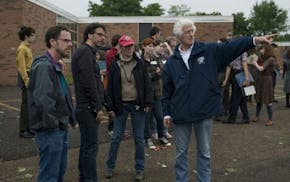A bald eagle flew low over my car with a good-sized tree branch gripped in one talon recently, something I didn't expect to see while driving over the I-35W bridge toward downtown Minneapolis.
However, this kind of sight is becoming almost commonplace, as more and more bald eagles are building their nests in the metro area, alongside busy highways, railroad tracks, shipping channels, even airports. That big raptor with the stick was refurbishing its large nest in a tree along the Mississippi River, just west of the 35W bridge.
It isn't all that surprising that eagles are becoming a familiar sight, so habituated to human activity that they raise their young in nests figuratively — and literally — right in our backyards. The Twin Cities are noisier and more crowded than a northern lake would be, but the metro Mississippi offers what bald eagles need, dense woodlands along the shoreline, with many tall cottonwood trees to hold nests, and a reliable supply of fish in the water.
John Moriarty spent an April morning in a small helicopter, traveling along the Mississippi from Dayton to Prescott, Wis., to count active eagle nests. The wildlife manager for the Three Rivers Park District found 53 active nests along that 70 miles of river that comprises the Mississippi National River and Recreation Area. It takes an eagle eye to spot dark nest lumps accompanied by dark eagle lumps in dark trees while flying about 150 feet above the ground at 60 miles per hour. As Moriarty pointed out, this annual count isn't really a true census of metro eagles.
"There probably are a lot of eagles that don't get counted," he says, noting that the river survey takes in the shoreline and about a block back into the woods. Any eagles with nests farther from the water, and any and all immature eagles not yet ready to nest don't get counted.
Still, these annual counts show a steady, positive trend from the dark days in the 1960s when bald eagle numbers were dwindling so badly that the raptor came under the protection of the Endangered Species Act. The number of metro eagle nests has more than tripled in 13 years, a fact that encourages the National Park Service, the count's sponsor.
"The eagles along this stretch of the Mississippi seem very resilient and don't seem fazed by human activity," said Nancy Duncan, natural resources program manager for the Park Service. "We're doing the counts to monitor trends in their population within the corridor to ensure their long-term health and survival."
Although nearly all the occupied nests are near the top of tall cottonwood trees, there are a few anomalies. A single nest sits on a human-made structure, a utility tower within Lilydale Regional Park in St. Paul. There are two known nests atop backyard evergreens, one in the Dayton's Bluff area of St. Paul, the other near the Lake Street-Marshall Avenue Bridge, on the Minneapolis side.
Is the river reaching its limit for bald eagle nests? Moriarty doesn't think so.
"There are thousands of cottonwood trees out there, waiting for bald eagles," he said, adding that nest building will slow down over time, but there's still plenty of room for growth. Showing how eagles can become habituated to human activity and to nesting near each other, Moriarty pointed to a map showing eight active nests along Pig's Eye Regional Park's 500-acre lake in St. Paul.
These big birds are masters of resilience, flying back from the edge of extinction. After being taken off the federal endangered species list in 2007, the birds have continued to rebound, their numbers expanding without human intercession. The best way to show our appreciation: Stand back and watch, in awe, from a distance.
St. Paul resident Val Cunningham, who volunteers with the St. Paul Audubon Society and writes about nature for local, regional and national newspapers and magazines, can be reached at valwrites@comcast.net.

Meet the Oscar-winning cinematographer who has changed the way the movies look
An Algerian reporter says he was expelled from his country without explanation

A former deli maestro steps into Capt. von Trapp's shoes in Artistry's 'Sound of Music'

NPG vets Michael Bland and Sonny Thompson extend their brotherhood into a post-Prince duo

